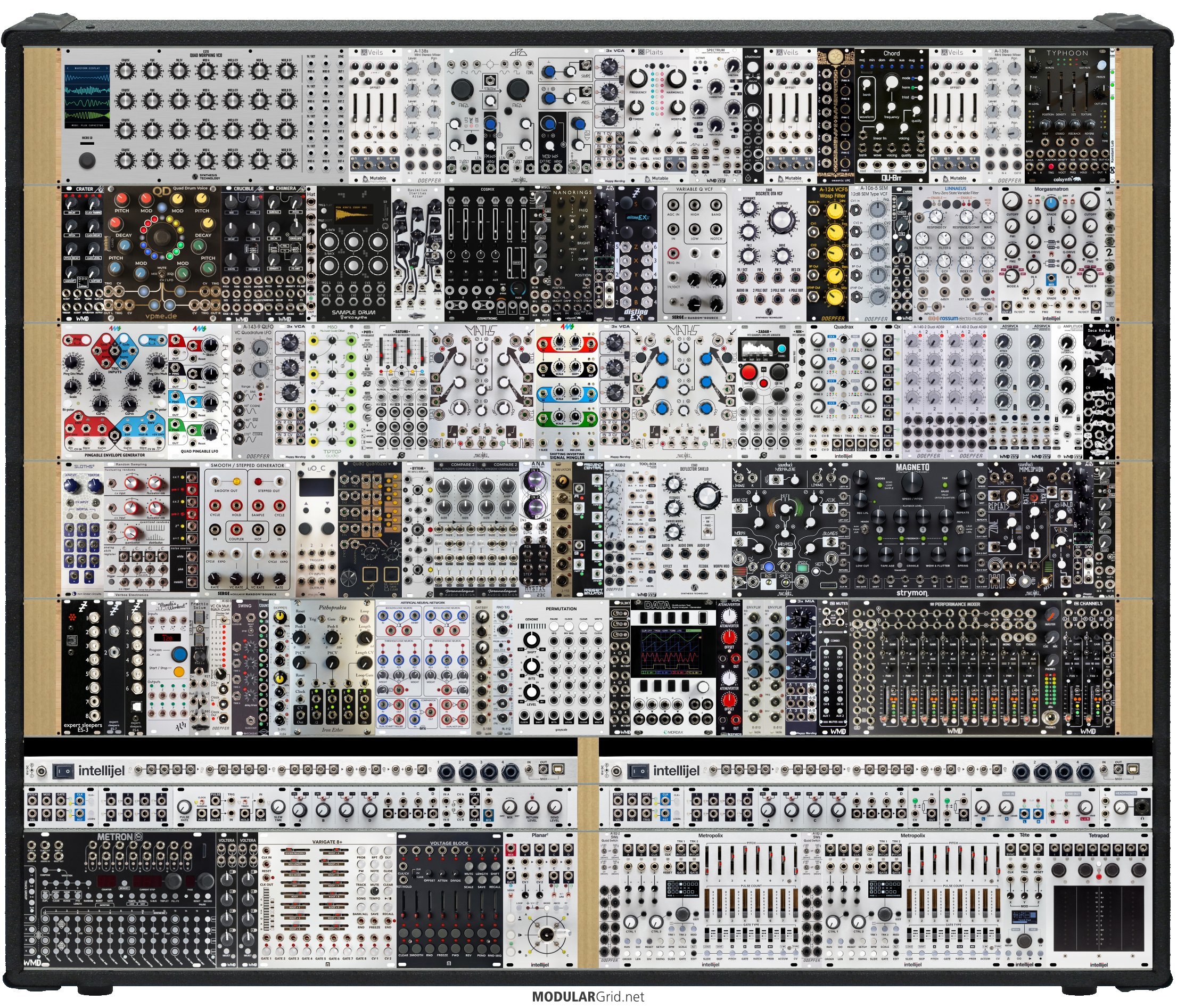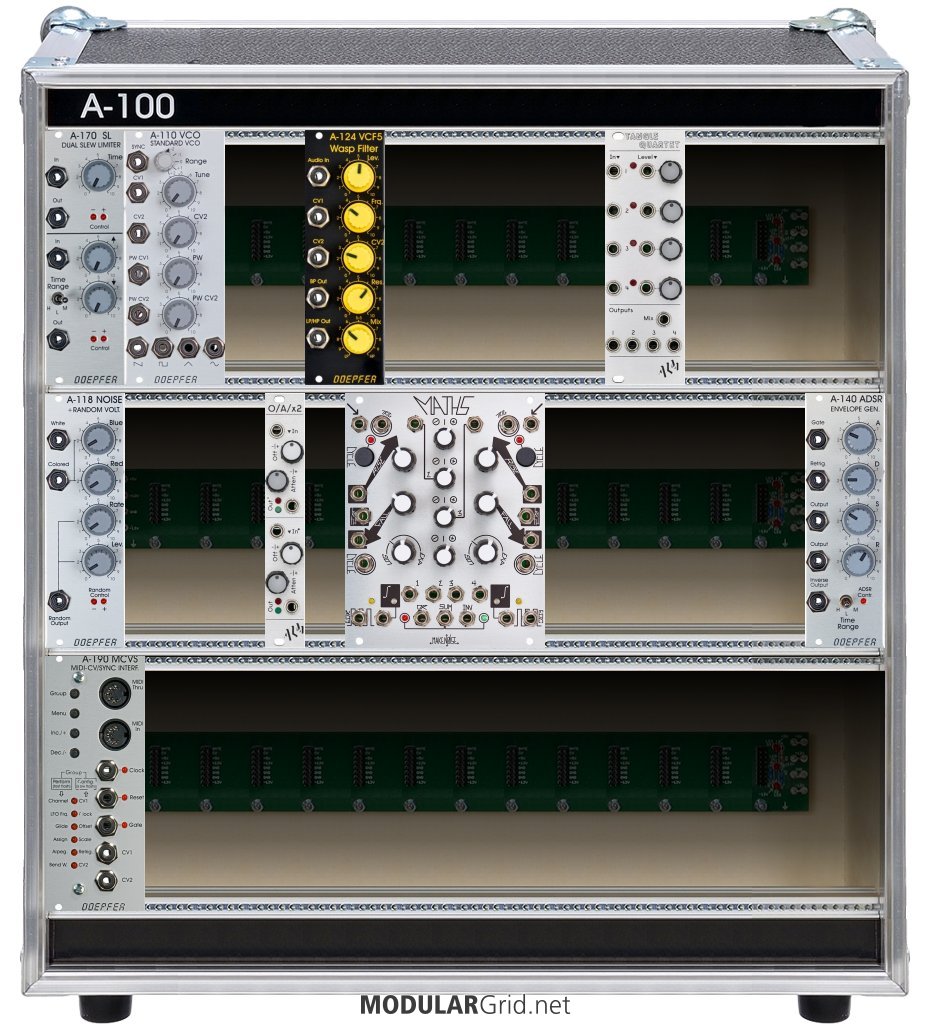Well, I can tell you that one of the biggest hurdles here is going to be abandoning the different "instruments" all over the build. But also, this is part of what makes it so daunting to fill out. Once you've divided up the cabs into separate functional zones, however, everything snaps into focus. Yes, there's going to be some long patchcords involved. And yes, I removed the "backside bus" modules because one other problem is going to be found in having those "hidden" patches, that being that relying on those modules actually makes it a bit more difficult to envision the patch in your head. After all, you not only have to sort out what the front panel cable tangle is about, you ALSO have to remember those unseen routings. Plus, chucking those modules opens up more space for function. Anyway...

Hoo, boy...this took a hot minute! I opted to try and fill the build out completely, so that you could get an idea as to what the original build made me think about the "where should this eventually go?" issue. Here's what's going on here...
TOP ROW: Mainly sources and ancillary modules for them. The E370 starts everything off, but then I added a Veils; since the E370 has four outputs, you can "strum" through them by using different LFOs, envelopes, etc to control the VCAs. After that, you have a Doepfer Mini Stereo mixer to stereoize the output, if desired...or you can just take the sum of the VCAs directly on to a VCF. DPO next, then a 3xVCA for that; you can use the multiple VCAs for a lot here...VCA over modulation level control, VCA over waveshaping, etc, and you still have one free for outputs. Or send three different waveforms to the VCA and have it scan through those. Plaits, Spectrum, and Chainsaw next, with another Veils for level control, then an Omsonic panning module gives you six inputs at unity gain with manual panning into a stereo out. This lets you composite those three VCOs into a single "voice". And then, I opted for some polyphony(ish) via a Qu-bit Chord v2, which then can feed its voices through another Veils/A-138s combo. I put the Typhoon after this, which puts it in place to act as yet another source with a great deal of freedom as to what you can feed it. And at the very end, a 1 hp Konstant Labs PWRchekr keeps tabs on the DC rail health.
SECOND ROW: On the left side was where I opted to combine all of the percussives. But at the end of those, I added a Cosmotronics Cosmix for submixing your drums, and put the MSCL, nanoRings, and one of the FX Aids after those for submix processing when needed. After that, I centrally located the Disting EX so that it's accessible from most anywhere in the build. On the opposite side are your filters; the first few are your current ones, then I pushed that on out with a Rossum Linneaus stereo thru-zero VCF and an Intellijel Morgasmotron dual VCF. The last bit there is a mono-stereo/stereo-mono spatial changer from Konstant Labs.
At this point, all of the audio sources and initial modifiers are located in those two topmost rows.
THIRD ROW: Modulation for days. I put in the two 4ms modules because they can work with very long periods, which is very useful for making changes that might take the length of a track to cycle through. The "pingable" concept used by them works well here, too, given the amount of sequencing going on and available pulses for their timing "pings". Then I put in a quadrature LFO, as those quadrature-shifted sines can be VERY useful (as in, say, strumming the E370's VCAs above, or doing the same with the chord pitches from the Chord). First modifier is next, with a MISO and a 3xVCA. Then the Batumi/Poti handles the more "normal" LFO duties. First Maths is after this, then the second modulation modifier...but this time, I put in a SISM which then allows other modulation signals to control modulating them. This, as you've probably guessed, vectors the build a bit toward generative work. Second Maths is after the SISM/3xVCA, then the Zadar/Nin gets us into the envelopes with a Quadrax/Qx, two dual ADSRs, dual ADSRVCAs, then your "character" VCAs are at the right end.
FOURTH ROW: Random signals are first, with a Nonlinearcircuits Triple Sloth for making VERY slow modulation activities that, while random, can take several HOURS to cycle. These are great for adding (with the Palette adders) to modulation signals for the VCFs, creating small, slow shifts in timbre. I put one of Mark Verbos' Buchla-inspired random source modules next; these not only provide plenty of random signals, but they contain an analog shift register, which is a great tool for generating arpeggi, pitch hocketing, and the like. Then a bit of Serge comes in with an Serge SSG for tackling the various random/mod curves and wrangling them into stepped/sloped waveforms. Ornament and Crime fits nicely with that, then I added a 4-channel quantizer with user-definition over scales. Now...why do that? Easy...quantizing + modulation + a good clock = cascades of pitches that rise and fall depending on what modulator the quantizer is reading. This in a way adds a whole new form of pattern generation to the original build. The gate/triggers can then be summed by the Bytom and sent as a composite to...well, anywhere you like, but the NEXT row provides loads of possibilities. Then a pair of Joranalogue dual window comparators also reads the modulation signals...but THEY output gate signals when specified voltage thresholds are crossed. You can get several gates from just one window comparator, so having FOUR lets you dive head-first into generative turf. After those, there's some CV modifiers, notable Mystic Circuits ANA, which is an analog arithmetical processor that derives sums, differences, maximums and minimums from modulation. Plus, a Ladik Derivator can also read CV motion, outputting gates when an inputted CV rises, falls, stays the same, or moves at all. The "little" logic processor (Frequency Central's Reset Simulation) gives you some basic Boolean gates that can either be used "there", or it can also feed those to the next row down. After this, I put in a Doepfer CVable dual polarizer for CV over inversion/levels, then SSF's Tool Box, which is a little "one stop" module for a number of useful functions. Then your FX are above the Performance Mixer for convenience and clarity, and I added a Synthesis Technologies E560...so now, you've got a frequency shifter in addition to the other phase/chorus/flange things you can do with that module.
FIFTH ROW: Bottom of the ADDAC cab. Expert Sleepers' modules are at the left end to make it easier to access them with outside cables. Then the Pam's, and then a NE Fractio Solum, which is a CVable clock divider/multiplier. A separate ratcheting module is after this, then a four-channel gate delay to change gate positions. A little clock counter is after that, then a Ladik Skipper, an Euclidean pulse sequencer, and the whole point of these (and some of the modules on Row #4): an ARC Artificial Neural Network for complex logic derivations that derive pulses from various other timing signal interference patterns. The Gatesby module is for converting triggers to gates, when needed, and one last Ladik module there fires off probabilistically-determined gate/trigger signals just to keep things a bit more "interesting". Then another bit of random fun, a full version of Greyscale's Permutation, which is a random looping sequencer that's based on the Turing Machine. And a WMD SL3KT then gives you a trio of electronic A-B bidirectional switches. After that is where I moved the DATA so that it can get more use as a diagnostic tool in addition to its other sonic functions. The Befaco attenuators are next, and by them I placed a pair of Ladik envelope followers, with the Befaco now aimed to be used as level controls for the envelope follower feeds. These let you use your stereo inputs to not only input external audio, but you can use audio as well as a lot of other signals to fire these, and they'll output gates AND the derived envelope. They're down here because...well, why spoil the surprise, hm? Anyway, I put the 3xMIA next to serve as a utility mixer for summing signals pre-mix, then the new thing next to it is the Performance Mixer's Mute section. And, natch, the Performance Mixer takes over the rest of the row; I put the fader expander to the right of the mixer in here so that there's a better fit with using the two stereo faders as extra FX returns.
PALETTES: You'll notice that I added a row so that the Palette case modules are now visible. This was very deliberate so that you could see that there's a bunch of I/O possibilities there that were being underexploited. For example, each cab now has the 1U MIDI Interface with the output expander. But the 1/4" jacks on the left Palette were screaming for use...so I put in an FX loop tile at the right end of the first Palette, which connects on the backside to the 1/4" jacks to allow external FX into the system. You can even VCA the output and input levels via the dual VCA next to the loop module. The sequencers remained much the same, but I added a Varigate 8+ to beef up the capabilities of the Voltage Block as well as to give it the memory functions that the Varigate provides. Both Metropolixes also now have quad sequential switches for altering sequences, routing functions, etc. And ALL of the audio ins and outs now go through the right Palette's 1/4" jacks, with the I/O tile right below.
Also, you'll notice that the cab in this build now reflects the reality of your case situation; that was probably another stumbling block, trying to sort out the 104 hp Palettes against the monster ADDAC 197 hp case. I even had problems with this until adding all of the "cardboard" spacers and expanding the build to 212 hp so that I could have 2 x 104 + 4 (spacer) to accommodate the Palettes.
At first, it might seem as if this would be a patchcord jungle when patched. But the reality is that there's a flow there: control signals move up on the left side (more or less) to the top tow rows, and audio flows back from them back down the right side. Controllers/sequencers are all on the "flat" row in the Palettes, and I was relatively careful about maintaining cable flow from the Palettes to the ADDAC and vice-versa. This IS what I recommend for large builds, though...by grouping functions in the same place, you actually wind up with a pretty intuitive layout when things get this big. Now, as for the mults...first of all, each Palette has three buffered mults, so anything needing a buffered CV source will be just fine. But for passives, I suggest going with inline mult widgets or stackcables instead. Admittedly, this build does teeter on that decision line between "no mults" and "add some mults", but I felt that the Palettes dealt with this issue just fine. Also, keep in mind that they also have two precision adders apiece, plus your MIDI and audio I/O.


